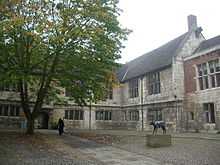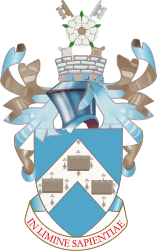Department of Archaeology at the University of York
| Department of Archaeology | |
|---|---|
|
The main courtyard at King's Manor | |
| Established | 1978 |
| Type | Academic department |
| Academic affiliation | University of York |
| Location |
York, Yorkshire, England 53°57′45″N 1°05′11″W / 53.9624°N 1.0865°WCoordinates: 53°57′45″N 1°05′11″W / 53.9624°N 1.0865°W |
| Head of Department | John Schofield |
| Academic staff | 20 |
| Undergraduates | 300 |
| Postgraduates | 100 |
| Website |
www |
The Department of Archaeology at the University of York is a department of archaeology which provides undergraduate and postgraduate courses in archaeology and its sub-disciplines and conducts associated research. It was founded in 1978 and has grown from a small department based at Micklegate House to more than a hundred undergraduate students based at King's Manor and with scientific facilities at the BioArCh centre on the main campus.
Hosted organisations, research specialities and fieldwork
The archaeology department hosts several specialist organisations:
- Archaeology Data Service - an open access digital archive for archaeological research outputs
- Internet Archaeology - a fully peer-reviewed electronic journal for archaeology
- BioArCh - a specialist centre using scientific and molecular techniques for archaeology
- Centre for Digital Heritage - an interdisciplinary centre studying computer-based approaches to heritage. Working with the universities of Aarhus (Denmark), Leiden (Netherlands), Lund (Sweden), Uppsala (Sweden).
- The Post Hole - is an archaeology journal run by students.[1]
The department's faculty has led significant archaeological investigations across Great Britain and occasionally further afield
| Site | Image | Location | Period(s) | Director(s) | Years excavated |
|---|---|---|---|---|---|
| Star Carr | 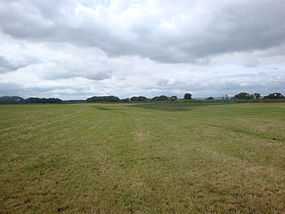 | North Yorkshire | Mesolithic | Chantal Conneller (Manchester) Nicky Milner, Barry Taylor (Chester) | 2003-2015[2] |
| Castell Henllys |  | Pembrokeshire | Iron Age | Harold Mytum | |
| Sutton Hoo | | Suffolk | Anglo-Saxon | Martin Carver | 1983-1992 |
| Wharram Percy | 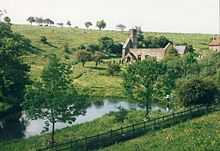 | East Yorkshire | Medieval | Philip Rahtz (among others) | 1950-1990 |
History
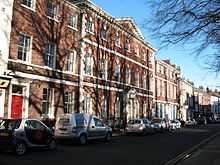
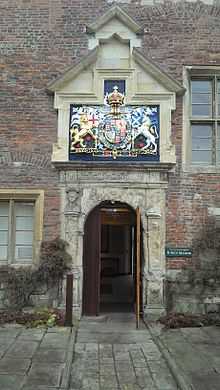
The department opened in 1978, 15 years after the university itself. The first head of department, Philip Rahtz built a thematic undergraduate programme specialising in the British Middle Ages. The programme included a 12-week field course in archaeological excavation.[3] The department expanded under Martin Carver after his appointment in 1986. A postgraduate programme was added and the department moved to King's Manor. Subsequently the department has grown in numbers of students, staff and the diversity of its specialisms: adding environmental archaeology, prehistory, computational archaeology, archaeological science and cultural heritage management.[3]
Faculty
Former faculty
Heads of department:
- Philip Rahtz - 1978-1986[3]
- Martin Carver - 1986-1996[3]
- Jane Grenville - 2001-2006[4]
Alumni
- Ken Dark, archaeologist : BA Archaeology, 1982[5]
- Helen Geake, archaeologist : DPhil Archaeology, 1991[6]
- Roberta Gilchrist, archaeologist : DPhil Archaeology, 1989[7]
- Greg Jenner - Historical Consultant to CBBC's multi-award winning 'Horrible Histories'[8]
- Leen Ritmeyer, archaeologist : MA Conservation Studies[9]
- Ben Robinson, The Flying Archaeologist (BBC Series) : PhD Archaeology [10]
Rankings and awards
Amongst archaeology departments, York ranked 2nd for Impact, 2nd equal for Environment, and 4th overall in the 2014 Research Assessment Exercise.[11] In the 2015 University Subject Tables, the department was ranked 6th out of 40 with a score of 92.6%.[12] The Department was awarded the Queen’s Anniversary Prize for Higher and Further Education in 2011[13]
References
- ↑ "The Post Hole". Retrieved 11 November 2011.
- ↑ "Recent Excavations". Star Carr website. Star Carr archaeology project. Retrieved 15 November 2014.
- ↑ 3.0 3.1 3.2 3.3 3.4 "History of the Department". Department of Archaeology Website. University of York. 13 November 2014. Retrieved 13 November 2014.
- ↑ "York & Antiquity". Martin Carver retirement website. Heritage Technology. Retrieved 15 November 2014.
- ↑ Landscapes of change: rural ... – Google Books. books.google.co.uk. Retrieved 1 March 2010.
- ↑ "channel4.com – Time Team – Meet the Team – Helen Geake". www.channel4.com. Retrieved 2 March 2010.
- ↑ "Professor Roberta Gilchrist – University of Reading". www.reading.ac.uk. Retrieved 2 March 2010.
- ↑ "IMDB Greg Jenner". www.imbd.com. Retrieved 10 October 2014.
- ↑ "About " Ritmeyer Archaeological Design". www.ritmeyer.com. Retrieved 4 March 2010.
- ↑ "Past postgraduate theses". www.york.ac.uk. Retrieved 1 December 2014.
- ↑ "REF 2014". http://www.ref.ac.uk/''. HEFCE. Retrieved 18 December 2014.
- ↑ "University Subject Tables - Archaeology". Subject Tables. The Complete University Guide. 12 May 2014. Retrieved 15 November 2014.
- ↑ "Previous Prize-winners". Queen's Anniversary Trust website. The Royal Anniversary Trust. Retrieved 15 November 2014.
External links
- Department of Archaeology Home Page
- Facebook page
- Google+ page
- The Posthole
- Internet Archaeology
- Archaeology Data Service
| |||||||||||||||||||||||||||||
